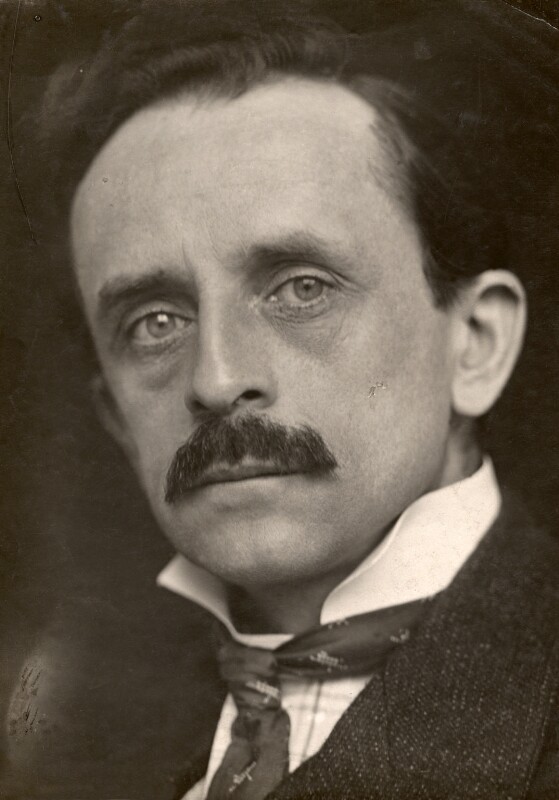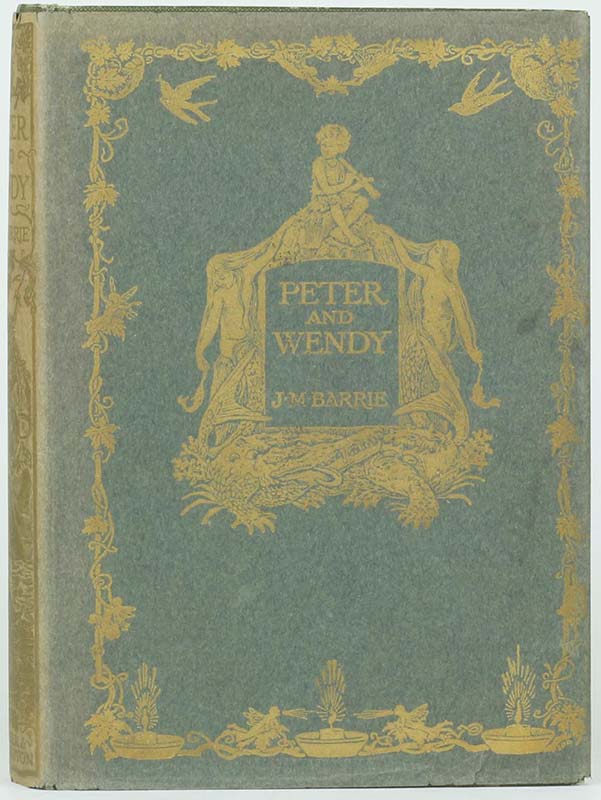Share via:
Sir. J.M. Barrie – Dramatist & Author 1860-1937

Scottish dramatist and author, 1860-1937. “Children have the strangest adventures without being troubled by them” wrote James Matthew Barrie. It is apt that Barrie penned this phrase, because with the publication of his masterpiece, Peter Pan and Wendy (1911), he introduced the children of England to the strangest adventure they would ever experience—a world of fairies, mermaids, a one-armed pirate, and a flying boy who refused to grow up. J.M. Barrie’s fantasy land had its roots in real-life events; the sudden death of his older brother and the attention Barrie lavished on his grieving mother manifest themselves in his veneration for mother figures and his interest in little boys who do not age.
The history of Peter Pan is one of the most complex in children’s literature. Peter began as a minor character in one of Barrie’s adult novels, The Little White Bird (1902), and later became the hero of his popular play, Peter Pan (first performed in 1904 and published in -1928), created for the amusement of the five Davies brothers, children with whom J.M. Barrie walked in Kensington Gardens. The version that has been passed down through generations combined the dramatic tale with its sequel, Peter Pan: An Afterthought; or, When Wendy Grew Up (1908). Peter, the leader of a band of children known as the Lost Boys, escorts a trio of London siblings—Wendy, Michael, and John Darling- through the clouds to Never Never Land, where they meet the villainous Captain Hook, the beautiful Tiger Lily, and the jealous Tinker Bell.

The literary history of Peter Pan is rivaled by its critical history. Soon after its publication, it was compared to a “breath of fresh air… a bit of pure phantasy” and was recommended for the “imaginative, the eternally youthful, and the pure in heart.” It was considered “the best thing [Barrie] has done—the thing most directly from within himself.” The critical tide turned in the second half of the century as Barrie’s work met with a different response; critics believed it portrayed incestuous and homosexual relationships and hinted at castration. It was said that the story was “one of the most fragmented and troubled works in the history of children’s fiction.” Some may continue to think that the images in Peter Pan are unsettling to young readers, but it seems best to follow advice written in 1920: “The most intelligent attitude to take toward Peter Pan is unconditional surrender. If one unreservedly yields one’s mind and heart to its enfolding charm, then one will understand.” Understand and, perhaps, fall in love with it over and over.
M.I.A.
Source: Children’s Books and their Creators, Anita Silvey.
Sir J.M. Barrie Works
Peter Pan
- The Little White Bird, or Adventures in Kensington Gardens (1902)
- Peter Pan (staged 1904, published 1928)
- Peter Pan in Kensington Gardens (1906)
- When Wendy Grew Up: An Afterthought (written – 1908, published 1957)
- Peter and Wendy (novel) (1911)
Other works
- Better Dead (1887)
- Auld Licht Idylls (1888)
- When a Man’s Single (1888)
- A Window in Thrums (1889)
- My Lady Nicotine (1890), republished in 1926 with the subtitle A Study in Smoke
- The Little Minister (1891)
- Richard Savage (1891)
- Ibsen’s Ghost (Toole Up-to-Date) (1891) Walker, London (1892)
- Jane Annie (opera), music by Ernest Ford, libretto by Barrie and Arthur Conan Doyle (1893)
- A Powerful Drug and Other Stories (1893)
- A Tillyloss Scandal (1893)
- Two of Them (1893)
- A Lady’s Shoe (1893) (two short stories: A Lady’s Shoe, The Inconsiderate Waiter)
- Life in a Country Manse (1894)
- Scotland’s Lament: A Poem on the Death of Robert Louis Stevenson (1895)
- Sentimental Tommy, The Story of His Boyhood (1896)
- Margaret Ogilvy (1896)
- Jess (1898) Tommy and Grizel (1900) The Wedding Guest (1900) The Boy Castaways of Black Lake Island (1901)
- Quality Street (play) (1901)
- The Admirable Crichton (play) (1902) Little Mary (1903) Alice Sit-by-the-Fire (play) (1905) Pantaloon (1905)
- What Every Woman Knows (play) (1908)
- Half an Hour (play) (1913)
- Half Hours (1914) includes:
- Pantaloon
- The Twelve-Pound Look
- Rosalind
- The Will
- The Legend of Leonora (1914)
- Der Tag (The Tragic Man) (Short play) (1914)
- The New Word (play) (1915) Charles Frohman: A Tribute (1915)
- Rosy Rapture (play) (1915)
- A Kiss for Cinderella (play) (1916)
- Real Thing at Last (play) (1916)
- Shakespeare’s Legacy (play) (1916)
- A Strange Play (play) (1917)
- Charwomen and the War or The Old Lady Shows her Medals (play) (1917)
- Dear Brutus (1917) (play)
- La Politesse (play) (1918) Echoes of the War (1918) Four plays, includes:
- The New Word
- The Old Lady Shows Her Medals (basis for the movie Seven Days Leave (1930), starring Gary Cooper)
- A Well-Remembered Voice
- Barbara’s Wedding
- A Kiss for Cinderella (play) (1920)
- Mary Rose (1920)
- The Twelve-Pound Look (1921)
- Courage, the Rectorial Address delivered at St. Andrews University (1922)
- The Author (1925)
- Biographical Introduction to Scott’s Last Expedition (preface) (orig. pub. 1913, introduction included in 1925 edition only)
- Cricket (1926)
- Shall We Join the Ladies? (1928) includes:
- Shall We Join the Ladies?
- Half an Hour
- Seven Women
- Old Friends
- The Greenwood Hat (1930)
- Farewell Miss Julie Logan (1932)
- The Boy David (1936)
- M’Connachie and J. M. B. (1938)
- story treatment for film As You Like It (1936)
- The Reconstruction of the Crime (play), co-written with E.V. Lucas (undated, first published 2017)
- Stories by English Authors: London (selected by Scribners, as contributor)
- Stories by English Authors: Scotland (selected by Scribners, as contributor)
